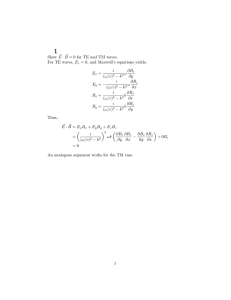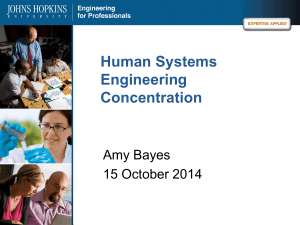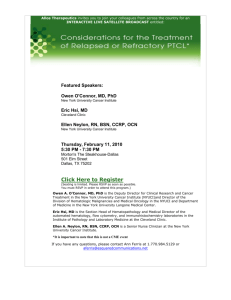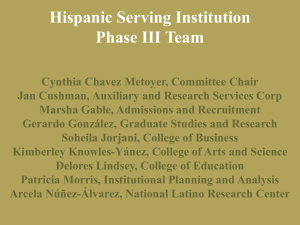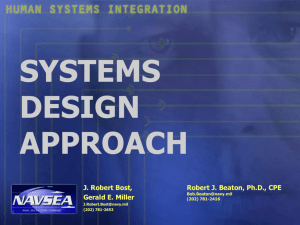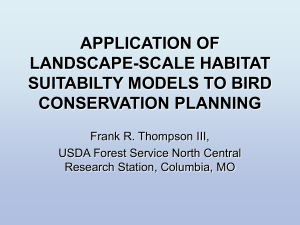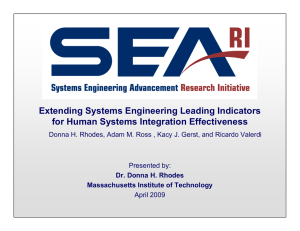presentation - Center for Software Engineering
advertisement
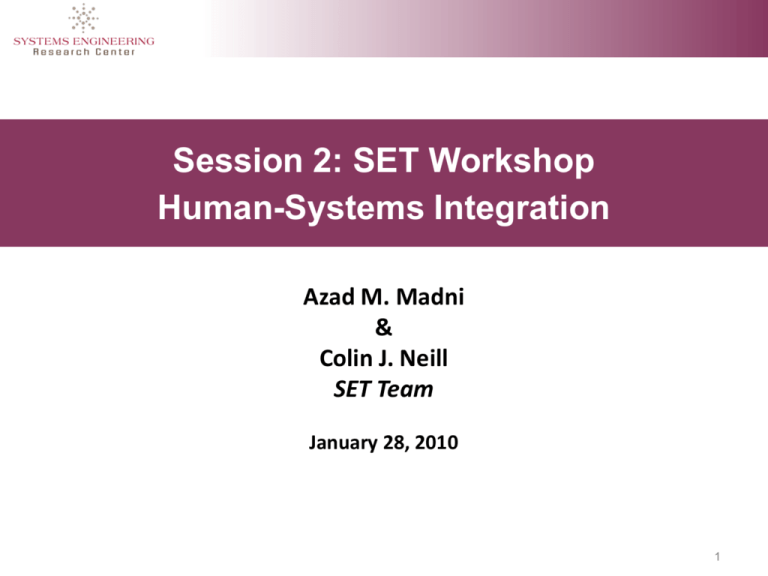
Session 2: SET Workshop Human-Systems Integration Azad M. Madni & Colin J. Neill SET Team January 28, 2010 1 Research Area Objectives ■ Produce innovative HSI methods for integrating humans with adaptable systems ■ Identify where and how HSI considerations need to be introduced within the SE lifecycle ■ Maximize developer-tool compatibility in systems architecting and design ■ Contribute to all SET Research Areas 12/1 6/20 2 09 What’s New in Proposed Approach ■ Explicitly takes into account human cognitive limitations human adaptively limitations task shedding behavior ■ Focuses on integrating humans with adaptable systems cognitive coupling during adaptation ■ Encompasses system developers’ skill set, capabilities, and limitations models of humans that interact with and are part of the system 12/1 6/20 3 09 Current Practice and Limitations ■ Designers continue to build systems that shore up/ compensate for human shortcomings because they view humans as suboptimal job performers (Madni, COCOMO Workshop, 2008) this mindset fails to capitalize on human ingenuity and creativity ■ Current methods rely on HFE tools that do not span the SE life cycle ■ Current methods do not address human adaptivity human interaction with adaptable systems where and how HSI considerations need to be introduced in SE life cycle ■ Current methods are ill-suited to dealing with human-intensive systems they tend to characterize human behaviors without taking into account human variability 12/1 6/20 4 09 Human-Systems Integration ■ Human-Systems Integration (HSI) is the study and design of interactions between humans and the system(s) they work (or interact) with in a manner that ensures safe, consistent, and efficient operations with error avoidance ■ HSI is intended to optimize joint performance of humans and systems in both normal and contingency operations ■ HSI considerations need to be addressed throughout the SE life cycle to circumvent the likelihood of human-system mismatches during actual task performance 12/1 6/20 5 09 Key HSI Considerations ■ Development developer-tool ■ compatibility relative to development tasks end user-system compatibility relative to operational tasks end user-system coupling during system adaptation Operation human as operator (i.e., controller, manager, supervisor) human as agent (i.e., teammate, backup, peer, subordinate) 6 Proposed R&D ■ Develop overall approach to identifying HSI concerns in the systems engineering life cycle ■ Identify unique HSI concerns that need to be addressed when building adaptable systems context-switching (e.g., adaptive multitasking) cognitive overload and task-shedding ■ Develop methodology and visualization formats that allow non-programmer users to address HSI concerns throughout SE life cycle ■ Demonstrate overall concept for adaptable system (e.g., adaptable netcentric services) with HSI as a central concern 12/1 6/20 7 09 Enhanced HSI Scope … SE Life Cycle HSI Considerations HSI considerations before/ during adaptation Dynamic System Adaptation Contexts HSI methods need to address both the full SE life cycle and dynamic system adaptation contexts. 8 Enhanced HSI Process ■ Specifically addresses HSI issues in integrating humans with adaptable software/systems ■ Based on principles from cognitive psychology and social science ■ HSI strategies take into account Technology Readiness Levels and attendant uncertainties ■ Ensures human-machine system operates within acceptable risk envelope 12/1 6/20 9 09 Payoffs ■ General robust human-system performance under routine and contingency operations exploitation of unique human capabilities reliable “cognitive coupling” during system adaptation (e.g., while system undergoing updates) enhanced developer-tool compatibility through “shared understanding” of development tasks ■ Project-specific provide value to existing MPTs and systems support SET Research Areas across SE life cycle 12/1 6/20 10 09 References • H.R. Booher, R, Beaton, and F. Greene, Human Systems Integration, in A. Sage and W.B. Rouse (Editors), Handbook of Systems Engineering and Modeling, John Wiley and Sons, Hoboken, NJ, 2009, pp. 1319-1356 • Defense Science Board, Defense Science Board Task Force on Patriot System Performance, Report Summary DTIC No. ADA435837, January 2005 • Department of Defense Handbook, Human Engineering Program Process and Procedures, MIL-HDBK-46855, January 31, 1996 • A.M. Madni, Integrating human factors, software and systems engineering: Challenges and opportunities, Proc of the 23rd International Forum on COCOMO and Systems/Software Cost Modeling and ICM Workshop 3, Davidson Conference Center, University of Southern California, October 27-30, 2008 • A.M. Madni, HUMANE: A knowledge-based simulation environment for human-machine function allocation, Proc of IEEE National Aerospace & Electronics Conference, Dayton, Ohio, May, 1988c • A.M. Madni, A. Sage, and C.C. Madni, Infusion of cognitive engineering into systems engineering processes and practices, Proc. of the 2005 IEEE International Conference on Systems, Man, and Cybernetics, October 10-12, 2005, Hawaii • R.W. Pew and A.S. Mavor, Human–system integration in the system development process: A New Look, National Academy Press, 2007 • T.B. Sheridan, Humans and automation: System design and research issues, John Wiley 12/1 Sons, 2002 6/20 11 09
